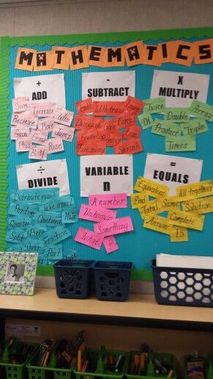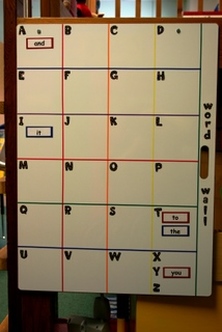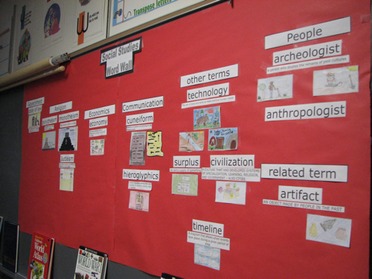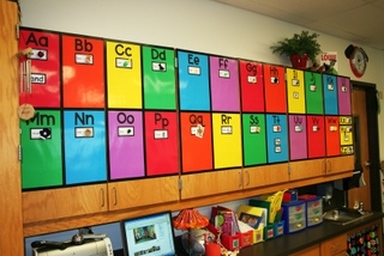What is a Word Wall?
Reading Rockets (n.d.) states that, "a word wall is a collection of words which are displayed in large visible letters on a wall, bulletin board, or other display surface in a classroom". Typically word walls take up a large space in the classroom, and the words are listed alphabetically by letter. For example, the words friend, family and finish would all be under the letter F. The words that go on a word wall can vary from teacher to teacher, however most teachers put sight words or content area words for a particular unit or theme (Echevarria, Vogt & Short, 2014). Reading Rockets gave a list of reasons why teachers should use word walls and they are as followed:
- "They provide a permanent model for high frequency words
- They help students see patterns and relationship in words, thus building phonics and spelling skills
- They provide reference support for children during reading and writing activities"
Visual Representations
|
This a video of a kindergarten teacher explaining how she uses a word wall in her classroom. She actually has two word walls. One that can be seen from everywhere in the classroom, and a traveling word wall. The traveling word wall are Popsicle sticks of each of the words in alphabetical order. If students need to write a word, for example family, they can take the family traveling stick and bring it back to their desk and write it.

This word wall is used on a mathematics classroom probably for upper elementary or middle school. Instead of labeling the word under the first letter, the words are labeled by what the words mean. For example, under the label "Add" the words more, sum and plus are there. These three words mean the same thing as add, so students are able to visually see multiple meanings for a math word.
|
Here is one example of a word wall. This word wall has a section for each letter, and under each letter are words that begin with a certain letter. There are also pictures next to the word to help students identify what the word is.

Above is another example of a word wall. This word wall is done on a magnetic board. The blog where this picture is taken from, says that the teacher creates multiple copies of words and stacks them on top of each other. This way if a student needs help spelling the word, for example, the student takes the word to their desk for them to use. Click on this link to read the blog: https://www.thedailycafe.com/articles/2-different-word-walls
|
Content Area Examples

Social Studies- This is an image of a word wall used for social studies. This word wall is not separated alphabetically instead it is separated by classification, such as technology and people. Under each vocabulary word, it gives a definition. This will help students because they have repeated exposure to not only the word but to the definition. Knowing that vocabulary development is essential for all students using a word wall one in more than just literacy is very beneficial to their learning.
Math- Just like in one of the images above, a word wall can also be used for math. In the image above the teacher wrote common math terms and then words that mean the same thing under those common math terms. The words minus and decrease are under the word subtract because those three words can be used interchangeably. This word wall will help students identify words that have multiple meanings, and this is especially helpful for struggling readers because this is often something they may struggle with. A teacher can also create a math word wall just like they would for a literacy word wall by going apathetically.
Science- Reading Rockets (n.d.) says that science is a fairly vocabulary heavy class because students need to learn vocabulary to be successful in making connections between concepts. Reading Rockets also said that, "when science students are given the opportunity to interact with the vocabulary, they are more likely to remember it." In a science classroom or for a science lesson, students could organize the word wall words by placing them in groups. As an example, words that deal with cells could be placed in one group on the word wall, and words that deal with elements can be placed in another group on the word wall.
Music- Similar to other content areas, a word wall can also be used in a music classroom. The music teacher can create the word wall alphabetically by different topics. For teachers that teach multiple grade levels, such as music, it might not be a bad idea to have multiple word walls for each grade. However the word wall should either be labeled by grade or it should be removable after each class such as a moving whiteboard. This way there isn't confusion on which word wall to look at.
Math- Just like in one of the images above, a word wall can also be used for math. In the image above the teacher wrote common math terms and then words that mean the same thing under those common math terms. The words minus and decrease are under the word subtract because those three words can be used interchangeably. This word wall will help students identify words that have multiple meanings, and this is especially helpful for struggling readers because this is often something they may struggle with. A teacher can also create a math word wall just like they would for a literacy word wall by going apathetically.
Science- Reading Rockets (n.d.) says that science is a fairly vocabulary heavy class because students need to learn vocabulary to be successful in making connections between concepts. Reading Rockets also said that, "when science students are given the opportunity to interact with the vocabulary, they are more likely to remember it." In a science classroom or for a science lesson, students could organize the word wall words by placing them in groups. As an example, words that deal with cells could be placed in one group on the word wall, and words that deal with elements can be placed in another group on the word wall.
Music- Similar to other content areas, a word wall can also be used in a music classroom. The music teacher can create the word wall alphabetically by different topics. For teachers that teach multiple grade levels, such as music, it might not be a bad idea to have multiple word walls for each grade. However the word wall should either be labeled by grade or it should be removable after each class such as a moving whiteboard. This way there isn't confusion on which word wall to look at.

